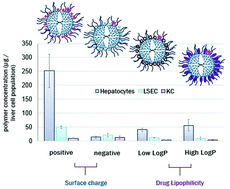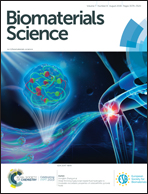Evaluating liver uptake and distribution of different poly(2-methyl-2-oxazoline) modified lysine dendrimers following intravenous administration†
Abstract
We report on the synthesis of four poly(2-methyl-2-oxazoline) modified lysine dendrimers with different residual groups or modifications on the dendrimer core, including: amino groups (positive charge), carboxyl groups (negative charge), and two drug molecules, one of which has a high log P. We looked at the in vivo distribution amongst three main liver cell types: hepatocytes, liver sinusoidal endothelial cells (LSECs) and Kupffer cells (KCs) and found differences in cell distribution and uptake concentrations dependent on these residual groups. In particular, the amino-functional polymer showed greater uptake by the hepatocytes whilst the carboxyl-functionalised polymer exhibited greater uptake by KCs and LSECs. These findings provide insight into which professional scavenger cells of the liver remove these types of nanoparticles from the bloodstream and we describe some of the design criteria to consider when creating novel drug delivery systems.



 Please wait while we load your content...
Please wait while we load your content...